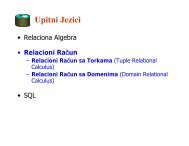Anytime, Anywhere Learning Behavior Using a ... - start [kondor.etf.rs]
Anytime, Anywhere Learning Behavior Using a ... - start [kondor.etf.rs]
Anytime, Anywhere Learning Behavior Using a ... - start [kondor.etf.rs]
You also want an ePaper? Increase the reach of your titles
YUMPU automatically turns print PDFs into web optimized ePapers that Google loves.
oriented teamwork.<br />
Thus, e-Education fits to a multitude of learning theories<br />
focusing on flexibility in time and space and student-centered<br />
learning. It is possible to support e.g. situated cognition (or<br />
situated/anchored learning [4],[5]), where it is argued that<br />
students learn most if they solve authentic problems of<br />
pe<strong>rs</strong>onal interest based on constructivism. New media may<br />
help to organize, distribute and put together the results based<br />
on pe<strong>rs</strong>onal interests by e.g. using Web space for publishing<br />
multimedia enriched literature researches or to present solved<br />
problems. Besides, collaborative learning is another promising<br />
approach which is perfectly supported via learning platforms<br />
and computational appliances [6]. <strong>Using</strong> a Web-based learning<br />
platform, students and lecture<strong>rs</strong> may communicate via<br />
commonly known browse<strong>rs</strong> to share problems, ideas and<br />
solutions in an informal way. However, since learning is a<br />
social process, introducing means for expressing emotions,<br />
taking different roles or allowing feedback are still immature<br />
in learning platforms. Furthermore, motivation and guidance<br />
based on the pe<strong>rs</strong>onality of the lecturer (or other students) is<br />
often neither considered nor supported.<br />
B. Ubiquitous <strong>Learning</strong><br />
<strong>Using</strong> a ubiquitous and mobile supporting infrastructure, a<br />
multitude of new situations arise and may be supported by the<br />
learning platform. Besides the requirements and learning<br />
techniques addressed by e-<strong>Learning</strong>, location dependent<br />
knowledge and situation dependent support are added.<br />
Mobile learne<strong>rs</strong> may be differentiated into actually moving<br />
pe<strong>rs</strong>ons or being temporary stationary just using a mobile<br />
device. Most probably, roaming students are rather not<br />
concentrated or short-term-focused learne<strong>rs</strong>, but they may use<br />
resources currently in the line of sight or radio coverage, like a<br />
poster or a solution for an exam on the table or on the screen<br />
of a notebook in front of another student using ad-hoc<br />
networks. In contrast, learning sessions of temporary stationary<br />
students may last a few hou<strong>rs</strong> and are comparable to traditional<br />
e-<strong>Learning</strong> settings at home, except perhaps the lack of<br />
concentration due to environmental sensations at the<br />
Unive<strong>rs</strong>ity campus or in a cafe.<br />
<strong>Using</strong> wireless network technology, like e.g. GSM/GPRS or<br />
W-LAN, mobile students depend on the availability of the<br />
network (e.g. W-LAN hot spots at the Unive<strong>rs</strong>ity campus,<br />
cafes, airports, etc.), the bandwidth and the costs. In addition<br />
to the increasing number of W-LAN hot spots, future cellular<br />
networks will help to provide coverage with broadband<br />
wireless technology (3G at 144Kb/s mobile and 2Mb/s static;<br />
4G at 2Mb/s mobile and 10-600Mb/s static [11]).<br />
Furthermore, the display of mobile devices is usually<br />
smaller and the battery performance is still not convincing.<br />
Therefore, such devices cannot be dispatched for time<br />
intensive use, but the learning modules and items have to be<br />
split into small and fitting unities and the presentation is<br />
supposed to change depending on the capabilities of the<br />
device. Thus, here the separation of content and presentation is<br />
a main design requirement.<br />
It is expected, that the enabling technologies foster a<br />
paradigm shift in learning, stressing on communication, direct<br />
and on demand exchange of information between students and<br />
lecture<strong>rs</strong> just-in-time. As a consequence, we will be able not<br />
just to accompany beginne<strong>rs</strong> while becoming competent<br />
students, but also to enable and support students to become<br />
experts when handling authentic and complex problems [7],<br />
which is a main goal in Unive<strong>rs</strong>ity education.<br />
III. DISTANCE EDUCATION VIA A WEB-BASED LEARNING<br />
PLATFORM<br />
Whenever e-<strong>Learning</strong> is discussed, distance learning<br />
approaches are compared to approaches that support students<br />
with wired and wireless technology in class. Since our lecture<br />
is a laboratory cou<strong>rs</strong>e about concepts and programming of<br />
distributed systems, learning is highly focused on self-study<br />
and working in teams. Hence, we decided to focus on<br />
supporting distance learning.<br />
A. Platform Architecture<br />
There are several good reasons for choosing a Web-based<br />
platform for our experiment. Fi<strong>rs</strong>t, the Web is accessible<br />
almost from anywhere via an arbitrary browser. Secondly,<br />
HTML combined with Java Applets provide sufficient<br />
accompanying support for a laboratory cou<strong>rs</strong>e, where content<br />
provisioning and delivery is much less important than the<br />
students’ work and discussions on selected topics.<br />
Client side<br />
Server side<br />
PC<br />
Notebook<br />
Internet<br />
PDA<br />
Server for Web server Server running:<br />
ssh access<br />
Tomcat servlet container<br />
Chat server<br />
Java framework<br />
MySQL<br />
Figure 1: Web-based learning platform architecture<br />
To support different types of devices with different<br />
capabilities, like the display size, the platform is easy to use<br />
and uses a simple interface. Thus, it is accessible from any<br />
Java enabled Web browser. The whole platform consists of<br />
Web pages and most of the content, like student data, lecture<br />
content and contribution to the different forums is retrieved<br />
from a MySQL database. Java classes and the JDBC/ODBC<br />
bridge are used for database access and Java Server Pages<br />
(JSPs) [8] are used for producing the presentation, i.e. the<br />
Web pages. Due to the security and Web server policy of the<br />
department, we use a Web server as a general portal and a<br />
Jakarta Tomcat server [14] on another host as a servlet<br />
2


![Anytime, Anywhere Learning Behavior Using a ... - start [kondor.etf.rs]](https://img.yumpu.com/3996703/2/500x640/anytime-anywhere-learning-behavior-using-a-start-kondoretfrs.jpg)


![Proposal - start [kondor.etf.rs]](https://img.yumpu.com/3715277/1/190x245/proposal-start-kondoretfrs.jpg?quality=85)